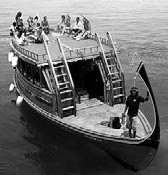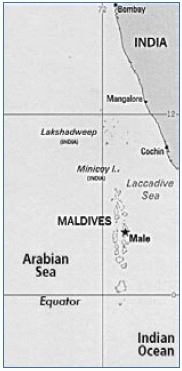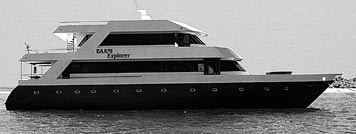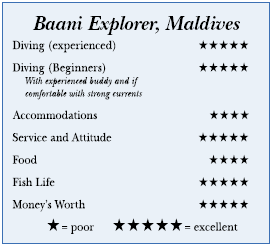The Baani Explorer, MaldivesContents of this Issue: Beat the Bite. . . avoiding mosquitoes Grand Turk, Turks and Caicos Islands Deep Injury: Will Your Insurance Company Be There? Editorial Office: Ben Davison Publisher and Editor Undercurrent 3020 Bridgeway, Suite 102 Sausalito, CA 94965 a bargain for big fish from the January, 2006 issue of Undercurrent
Dear Fellow Divers, For most North American divers, the Republic of the Maldives, west of India, is off the radar screen. It shouldn’t be. First, for East Coast divers, travel time is no more than it takes to get to Indonesia; for West Coast divers, the travel time compares favorably to trips to Papua New Guinea. Second, the cost is comparable to many closer destinations. Airfare is $1200 and up and a two week special on the Baani Explorer cost $1600. Some people spend that much for a ten-day Cayman vacation. Third, your flight will land in the capital and no internal flights on suspicious small planes are required, so no extra charges for overweight bags, and no chance that a crate of chickens will replace your bag. Fourth, it’s a safe country. Fifth, in a word, the diving is superb. Here’s what our longtime reviewer reports about his October trip. * * * On the second dive of a two-week dive trip, I was hooked to the reef at 60 feet, amazed at the magnificent “dance of the devilfish.”
The terpsichorean swoops, dives and hovers of a dozen manta rays being serviced by cleaner wrasses confirmed that despite the 1998 coral bleaching and the 2004 tsunami, my decision to return to the Maldives was a sound one. Indeed, that dive was a predictor of the fine underwater viewing that I enjoyed every day during my voyage on the Baani Explorer. The Baani Explorer is operated by Austrians Nino and Gundi Holm, who previously owned and operated a replica Spanish galleon, the Barutheela, in the Maldives (see Undercurrent, August 1998). As characteristic of the Maldive live-aboard diving, an inboard-powered dive support vessel, a “dive dhoni,” accompanies the Baani everywhere. The roomy 48-foot dhoni holds the compressor, the tanks, and all dive gear including wet suits. The Baani Explorer itself is more like a floating hotel than a cramped dive boat. All diving is done from the dhoni, so the set-up is efficient and practical. Only cameras had to be carried back and forth. The 95-foot Baani Explorer has been operating for just a year. Wood paneled throughout, it’s richly decorated with Maldivian artifacts and art photos. Although 18 guests would be a crowd on other craft, this spacious boat never felt busy. Somehow, the hot tub on the bow did not seem all that incongruous. Of the nine cabins, two are honeymoon staterooms with queen beds on the top deck, where there was also a large, covered patio with lounge chairs. The forward cabin below in the bow is very roomy, though the only one with a semi-bunk bed. The other six cabins below have either twin or queen beds, good reading lights, a closet and individually controlled air-conditioning. Each cabin has a detached roomy bathroom with toilet, sink and shower, and was cleaned daily. I couldn’t dial the AC below 78 F, but my fellow passengers, Austrians and Germans (I was the only Yankee) chuckled at my desire for cooler air and kept their cabins ventilated with open portholes. With day temperatures in the 80’s, I would have preferred cranking the A/C down a few degrees. The usual gathering place was the covered back deck with two large tables, a water cooler, coffee and tea. The dive briefings –— always in English since all the Europeans aboard were bilingual –— were conducted there. A large whiteboard tracked all the dives and showed the three-dive schedule for the day (night dives were offered a few times a week). We discussed the dives, made friends, or enjoyed a magazine or book (most in languages other than English) from the library. The reference books (mostly in English) on the Maldives and its watery inhabitants were invaluable for identifying the unusual creatures. The typical diving day started with a wake-up knock at 6:00 a.m., followed by a half hour to perform the morning ablution and have coffee with cookies. At 6:30, divemasters Hussen, Latheef or Thipay gave the briefings, using a whiteboard and describing the probable currents and the likely creatures. Hussen has fifteen years diving experience, Latheef about five years. Thipay was a relatively new guide, specifically hired because of his great attitude and skill in the water. I was impressed watching him professionally handle an out-of-air situation with an Austrian. A few minutes after the briefing, I climbed down a starboard ladder into the dive dhoni. During the ride to the site in my assigned seat, I hooked up my regulator and donned my wet suit.
With two long benches on each side, baskets for masks and fins under the bench, and the tanks with BCDs in racks down the middle, I had ample room to suit up and move around. The Baani has dozens of dive sites logged into a handheld GPS device, a surefire way to find sites, especially the deep seamounts. First, a divemaster would enter to check the current. Back on the boat he would update us and with a gleeful shout enjoin us to dive. With a giant stride from one of four points, we’d hit the water. Dive guidelines were usually 100 feet for sixty minutes. With the only chamber on Bandos Resort Island, five miles from Male, this is no destination to forget safe diving principles. The Europeans were all safety conscious, although experience ranged from fewer than 50 dives to more than 500. On most dives I would head down to 100 feet and drift to the shark activity, along the way enjoying schools of barracuda, jacks, eagle rays, napoleon wrasse, turtles and surgeon fish. To end the dive I would slowly ascend to the top of the reef, among prolific angelfish, anthias, fusiliers, lionfish, snappers, unicornfish, sweetlips, triggerfish and hordes of bannerfish and butterfly fish. Particularly impressive were the anemones and their resident fish carpeting many reef areas. Two dive guides were always in the water and divers were in pairs –— they frown on solo diving. Thanks to good planning we were rarely in the water with divers from other boats. (More than a hundred live-aboards called “safari boats” serve the Maldives, but only a few meet American standards). After a safety stop I would inflate my sausage and wait to be picked up by the alert dhoni driver. Exits were an easy climb up a portside ladder. We dived three of the atoll systems. One memorable dive was at Fish Head, so named because the native fishermen in years past lost all but the heads of their catch to the gray reef sharks. This seamount has a flat top 30 feet from the surface and drops to 50 feet. I buddied up with Thipay (I buddied with the guides because the other guests were linked by marriage or friendship) and descended in 60-foot viz through clouds of darting fusiliers, finally stopping at 95 feet to watch a few white tip and gray reef sharks swim lazily about. A bullet train of barracuda raced back and forth, a different pattern than their usual wheeling circles. The coral was healthy and I saw nudibranchs, schooling jacks, and clouds of butterfly fish. A large Napoleon wrasse seemed to be begging for food –— an indication that he had been previously fed. Clearly a magnificent dive. Maaya Thila, nearby, was an equally wondrous dive, with great shark action and plenty of fishlife. The water was a consistent 80F, with occasional cooler thermoclines. The dive at Guiradhoo Corner featured a high-speed ride down the channel on a strong current in 70-foot viz. After we hooked in, Latheef and I closely observed six gray reef sharks patrolling, one a female with deep wounds on her flanks. A large resting stingray was oblivious to the action. This dive was a hammerhead shark search and though I struck out, several others got lucky. Instead, I saw several eagle rays in formation off the wall, a flying saucer of a turtle ambling up the channel, schools of snapper, trevally and a few dogtooth tuna. Ascending through the ubiquitous streaming fusiliers, I watched unicorn fish play in my rising bubbles. On a dive at Kolhuke Hi Thila, I spent time at the top of the reef watching dozens of sea cucumbers standing on end waving in the current like giant double-jointed kielbasas, emitting reproductive matter into the water. Latheef said locals collect them for export as beche-de-mer and they are growing scarce. We dived a couple of wrecks, the most notable being the Kuda Giri, which lies on its keel at 120 feet. In 50 ft. viz, Hussen and I scanned the excellent accumulation of sponges and corals and resident fish, including a small school of spadefish. In the hold were curtains of silversides and around the wreck swam jacks that were trying to nail a fusilier or two. Halfway through the dive I swam in moderate current to the nearby reef and checked out the rainbowed tropicals and a fierce-looking mantis shrimp scurrying from his hole. All this effort rumbles the stomach, and the Baani served me well. Though the salon/dining/bar area was not air-conditioned, open side doors and forward windows brought in a gentle, cooling breeze. The bar featured an assortment of liquors and San Miguel beer on tap. It’s a nonsmoking area, which I appreciated, seeing how many European divers smoked. Bottled beers and colas are kept in several coolers. Gayan, the cheerful barman, delivers icy drinks anytime, anywhere on board. (The usual prohibition about diving after drinking was in effect.) This was a comfortable place to relax and listen to music or watch movies. Camera buffs set up their computers here to view their digitally captured wonders. In the rear corner of the salon, Hussen Hamyz, the genial and capable boat manager and senior divemaster, conducted his business via the Internet on the ship computer and cell phone. The meals were what I might
expect in a Mediterranean resort
hotel. The dinners started with a
homemade soup, a salad and an appetizer,
e.g., sashimi or egg rolls.
The main course might be a steak
filet, broiled tuna, or a chicken
cordon bleu with carrots and broccoli
or peas. Desserts included orange
mousse, ice cream, batter-fried pineapple,
cakes and fresh fruit. Lunches
always included a salad and two main
choices, usually chicken or fish,
sometimes pizza. Often fried noodles
were on the menu, and ice cream and
fruit for desert. The long list of marine life I saw compared favorably to my previous Maldive log books. Despite some damaged reefs, the hard and soft corals lost in the 1998 El Nino were regenerating. I’ve had better visibility, however this voyage started at the end of the south-west monsoon. Besides diving, we had several island visits, one to a resort and one to a local shipbuilding (and shopping) village. Rain cancelled a planned night banquet/picnic on an islet, but no one seemed to mind. When the trip ended, the Baani returned to a marina close to the airport. They ferried us from the boat to the airport to meet flight schedules. Pampered by the batik-clad “Stepford Wife” flight attendants of Singapore Airlines and relaxing on the long flight home, I summed up the past two weeks. A good trip, at a good price, on a good boat, with good food, a good crew, good companions, and good diving. A man can’t ask for much more than that. PS: The new Peter Hughes Ocean Dancer has been assigned to the Maldives. A February 2006 one-week trip will cost $2360, including a port charge of $65, plus a fuel charge of $100. A February week aboard the Baani will run $1176. What could I get from the new Ocean Dancer for twice the price that I didn’t get on the Baani? Well, I would get my own bar of soap in the bathroom. On the Baani, none, but it must be a European tradition. The Germans knew they had to furnish their own soap and they looked at me as if I were crazy. And, on the Ocean Dancer, you’ll be accompanied by fellow Americans. But, if you enjoy new experiences, a boatload of Europeans can broaden your horizons, while saving you a grand. ––E.E.
|

I want to get all the stories! Tell me how I can become an Undercurrent Online Member and get online access to all the articles of Undercurrent as well as thousands of first hand reports on dive operations world-wide
| Home | Online Members Area | My Account |
Login
|
Join
|
| Travel Index |
Dive Resort & Liveaboard Reviews
|
Featured Reports
|
Recent
Issues
|
Back Issues
|
|
Dive Gear
Index
|
Health/Safety Index
|
Environment & Misc.
Index
|
Seasonal Planner
|
Blogs
|
Free Articles
|
Book Picks
|
News
|
|
Special Offers
|
RSS
|
FAQ
|
About Us
|
Contact Us
|
Links
|
3020 Bridgeway, Ste 102, Sausalito, Ca 94965
All rights reserved.


 The Maldives are part of the Laccadives-Chagos
Ridge that rises 12,000 ft. from the floor of the
Indian Ocean. Thousands of sand spits, islets and lowlying
islands form 19 coral atoll systems, a diving
magnet that attracts thousands of Europeans annually.
Tidal action brings inbound currents and clear nutrient-
rich water. The outbound currents clean out the
lagoons. Both provide feeding opportunities for pelagics.
Diving with these currents at the passes (Kandus)
or at sea mounts (Thilas) provides plenty of action,
and the slow ascent to the colorful reef top is a fine
way to end any dive.
The Maldives are part of the Laccadives-Chagos
Ridge that rises 12,000 ft. from the floor of the
Indian Ocean. Thousands of sand spits, islets and lowlying
islands form 19 coral atoll systems, a diving
magnet that attracts thousands of Europeans annually.
Tidal action brings inbound currents and clear nutrient-
rich water. The outbound currents clean out the
lagoons. Both provide feeding opportunities for pelagics.
Diving with these currents at the passes (Kandus)
or at sea mounts (Thilas) provides plenty of action,
and the slow ascent to the colorful reef top is a fine
way to end any dive. 
 Snacks like brown- ies, tiny tuna sandwiches, or fried dumplings
were served in the afternoon. The
bountiful breakfast after the first dive
included a fresh pineapple, watermelon, and
papaya. Corn flakes, cheese and tuna fish
salad were available as were eggs to order,
sausage, toast and rolls. Except for the
dinner main course, guests served themselves
from a salad bar (on a large model
dhoni) and from a buffet counter.
Snacks like brown- ies, tiny tuna sandwiches, or fried dumplings
were served in the afternoon. The
bountiful breakfast after the first dive
included a fresh pineapple, watermelon, and
papaya. Corn flakes, cheese and tuna fish
salad were available as were eggs to order,
sausage, toast and rolls. Except for the
dinner main course, guests served themselves
from a salad bar (on a large model
dhoni) and from a buffet counter. Divers Compass: Nineteen Airlines fly to Male, via Europe,
Singapore, Kuala Lumpur, and Colombo. Emirate Air flies (onestop)
from New York via Dubai. From the West Coast, Singapore and
Malaysian Airlines are options. . . I took a day room in Male coming
and going; there are good hotels and restaurants; sightseeing
and shopping for handicrafts can occupy a few hours. . . .
Both the Baani and the dive dhoni have oxygen. . . . You can’t
bring alcohol into the Maldives –– the 200,000 residents are Sunni
Muslims –– but drinks aboard were $2.50; if you don’t have scruples
about bringing cigarettes for the crew, a carton or two purchased at an airport
duty-free shop will go a long way in getting you super attention. . . .Bring
a 220V to 110V electrical converter with several European round and flat plug
adapters. . . .Tanks are 12 and 15 liters, approximately 80 and 100 cubic feet.
DIN/INT fittings. Although INT valve inserts are available for the tanks, if I had
a DIN fitting I would set it up on my regulator. . . . No Nitrox. . . .No need
to worry about crime or malaria in the Maldives and I never saw any hostility
toward Americans. . . . Transport from Male to the airport is 15 minutes by water
taxi. . . Visas for the Maldives are issued on arrival. . . .Guests can send and
receive email for a fee . . . Many Europeans brought their cell phones that “roamlinked”
into the Maldivian system; I was told, but couldn’t verify, that American cell phones would also link up. I booked with Dom Macan (
Divers Compass: Nineteen Airlines fly to Male, via Europe,
Singapore, Kuala Lumpur, and Colombo. Emirate Air flies (onestop)
from New York via Dubai. From the West Coast, Singapore and
Malaysian Airlines are options. . . I took a day room in Male coming
and going; there are good hotels and restaurants; sightseeing
and shopping for handicrafts can occupy a few hours. . . .
Both the Baani and the dive dhoni have oxygen. . . . You can’t
bring alcohol into the Maldives –– the 200,000 residents are Sunni
Muslims –– but drinks aboard were $2.50; if you don’t have scruples
about bringing cigarettes for the crew, a carton or two purchased at an airport
duty-free shop will go a long way in getting you super attention. . . .Bring
a 220V to 110V electrical converter with several European round and flat plug
adapters. . . .Tanks are 12 and 15 liters, approximately 80 and 100 cubic feet.
DIN/INT fittings. Although INT valve inserts are available for the tanks, if I had
a DIN fitting I would set it up on my regulator. . . . No Nitrox. . . .No need
to worry about crime or malaria in the Maldives and I never saw any hostility
toward Americans. . . . Transport from Male to the airport is 15 minutes by water
taxi. . . Visas for the Maldives are issued on arrival. . . .Guests can send and
receive email for a fee . . . Many Europeans brought their cell phones that “roamlinked”
into the Maldivian system; I was told, but couldn’t verify, that American cell phones would also link up. I booked with Dom Macan (